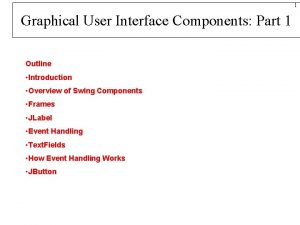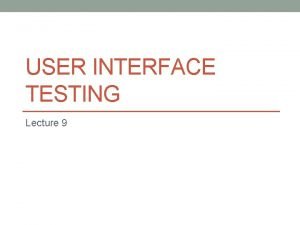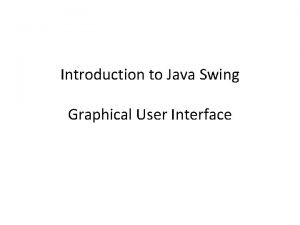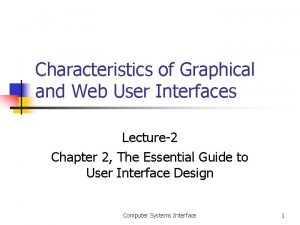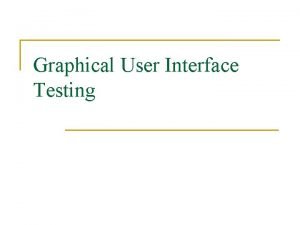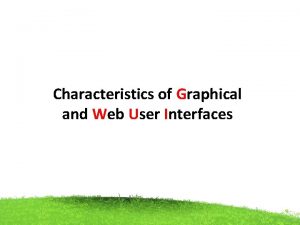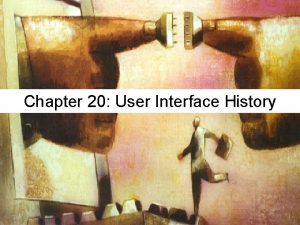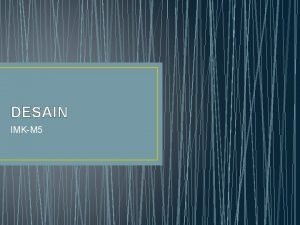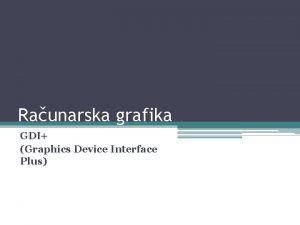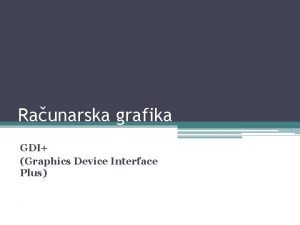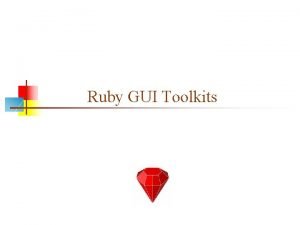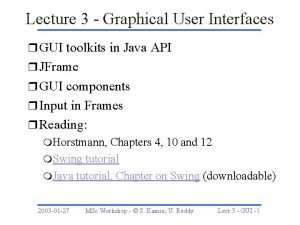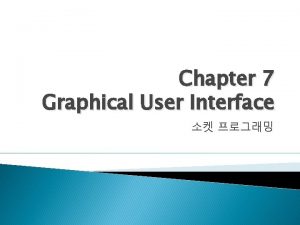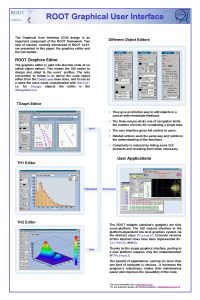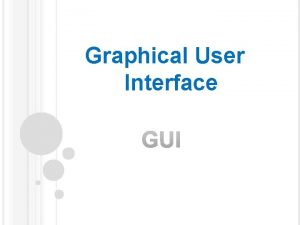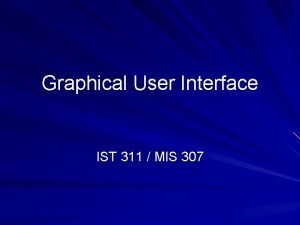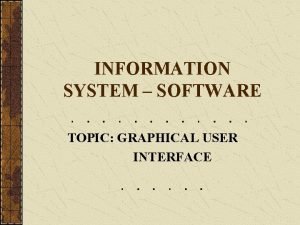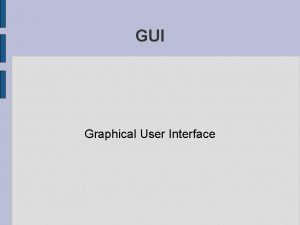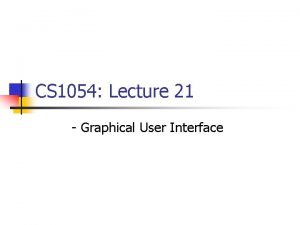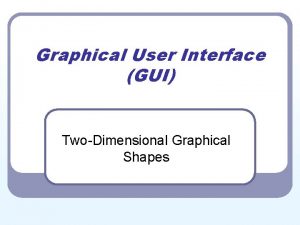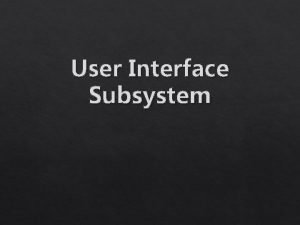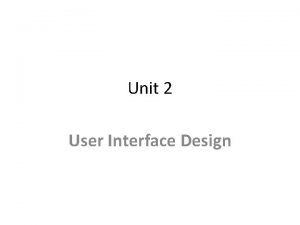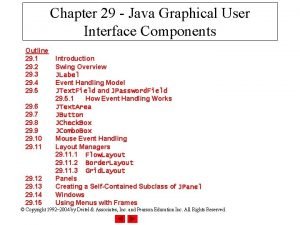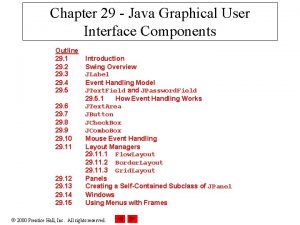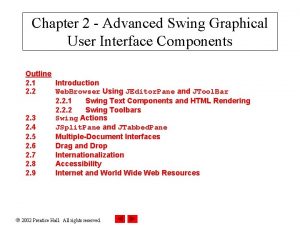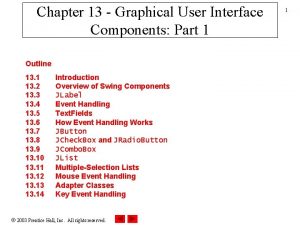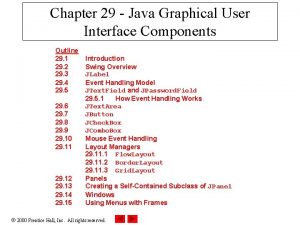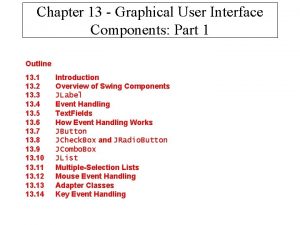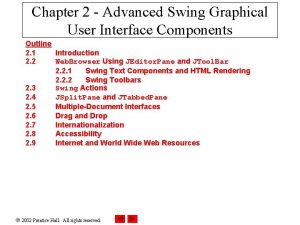Graphical User Interface Components Chapter 14 What You





















- Slides: 21

Graphical User Interface Components Chapter 14

What You Will Learn Text Areas n Sliders n Menus n – With frames – Pop up menus n Look and feel options 2

JText. Area for manipulating multiple lines of text n Extends JText. Component n – Inherits from that class View Figure 14. 1 n Note n – Creation of box – Creation of two JText. Area objects – Copy of marked text to other text area 3

Subclass of JPanel n A JPanel can – Aggregate a set of GUI components – Create dedicated drawing areas – Create areas that receive mouse events n Subclass of a JPanel should – Override method paint. Component – Call the superclass version as first statement n Note the customized JPanel subclass, Figure 14. 2 4

Demonstration of Customized JPanel Now view Figure 14. 3 n Note n – Declaration, instantiation of the Custom. Panel – Method draw used in action. Performed methods 5

Another Customized JPanel Class Possible for the (sub)class to handle its own events n Note Self. Contained. Panel class, Figure 14. 4 n This class has n – Mouse activity handlers – Preferred dimension specified – Call to paint. Component method n Figure 14. 5 uses this customized subclass 6

JSliders Enable users to select from range of integer values n Features n – Tick marks (major and minor) – Snap-to ticks – Orientation (horizontal and vertical) thumb tick mark 7

JSliders JPanel subclass for drawing circles, Figure 14. 7 n JSlider used to control size of a circle graphic, Figure 14. 8 n Note n – Slider declaration, implementation – Registration of listener for the slider 8

Using Menus with Frames Allows for performing actions with cluttering GUI n Contained by menu bar – JMenu. Bar n Comprised of menu items – Menu. Item n Note Figure 14. 9 n – Declares menu items – Populates the menus – Specifies actions for menu choices 9

JPopup. Menu n Menus that are context-sensitive – Right click and popup menu appears n In Swing, use JPopup. Menu – Provide options specific to component – Popup trigger event occurs when object right mouse clicked n Demonstration of JPopup. Menu shown in Figure 14. 10 10

Pluggable Look-and-Feel n Recall that Java is designed to run on variety of platforms – GUI components on a Mac, look different from those on a PC or on a UNIX platform n Look-and-Feel capability – Java program on a particular platform looks like other programs on the same platform – Also possible to specify the look-and-feel of a Swing GUI 11

Pluggable Look-and-Feel Figure 14. 11 demonstrates how to change the appearance n Note use of UIManager methods n 12

JDesktop. Pane and JInternal. Frame n Multiple document interface – Main (parent) window – Child windows View Figure 14. 12 which demonstrates this n Note n – Declaration, instantiation of JDesktop. Pane object – Choosing and painting of the icons 13

JTabbed. Pane n Arranges GUI components into layers – One layer visible at a time – Access each layer via a tab View tab demo program, Figure 14. 13 n Note n – declaration of tabbed panes 14

Layout Managers n Box. Layout arranges GUI components – Horizontally along x-axis – Vertically along y-axis 15

Box. Layout n Demonstrated in Figure 14. 15 – Also uses the tabs – Offers several different options for laying out three JButtons n Note – Creation of boxes – Adding of buttons 16

Grid. Bag. Layout Manager n Flexible Grid. Bag. Layout – Components can vary in size – Components can occupy multiple rows and columns – Components can be added in any order n Uses Grid. Bag. Constraints – Specifies how component is placed in Grid. Bag. Layout 17

Grid. Bag. Layout Manager n Grid. Bag. Constraints fields 18

Grid. Bag. Layout Manager n Designing a GUI to use the Grid. Bag. Layout Column 0 1 2 0 1 Row 2 3 n Program for this layout demonstrated in Figure 14. 19 19

Grid. Bag. Layout Manager n n Variation of Grid. Bag. Layout does not use gridx and gridy – Use constants RELATIVE and REMAINDER RELATIVE – Specifies next-to-last component placement in row or column – Component placed next to one previously added n REMAINDER – Specifies component as last component in row or column 20

Grid. Bag. Layout Manager Use of constraints demonstrated in Figure 14. 20 n Note n – Setting constraint weights – Setting grid width – Adding buttons – The add. Component method 21
 Components of graphical user interface
Components of graphical user interface Graphical user interface testing
Graphical user interface testing Input design principles
Input design principles Graphical user interface design principles
Graphical user interface design principles Introduction to graphical user interface
Introduction to graphical user interface Java graphical user interface
Java graphical user interface History of the gui
History of the gui Gui vs web interface
Gui vs web interface Gui meaning
Gui meaning Characteristics of graphical user interface
Characteristics of graphical user interface Jpanel
Jpanel Web user interface
Web user interface Graphical user interface history
Graphical user interface history User interface components
User interface components Meterpreter gui
Meterpreter gui Graphical device interface with c
Graphical device interface with c Snort front end
Snort front end Graphics device interface
Graphics device interface Gui toolkits
Gui toolkits Gui for r
Gui for r Interface in java
Interface in java Abowd and beale framework example
Abowd and beale framework example
